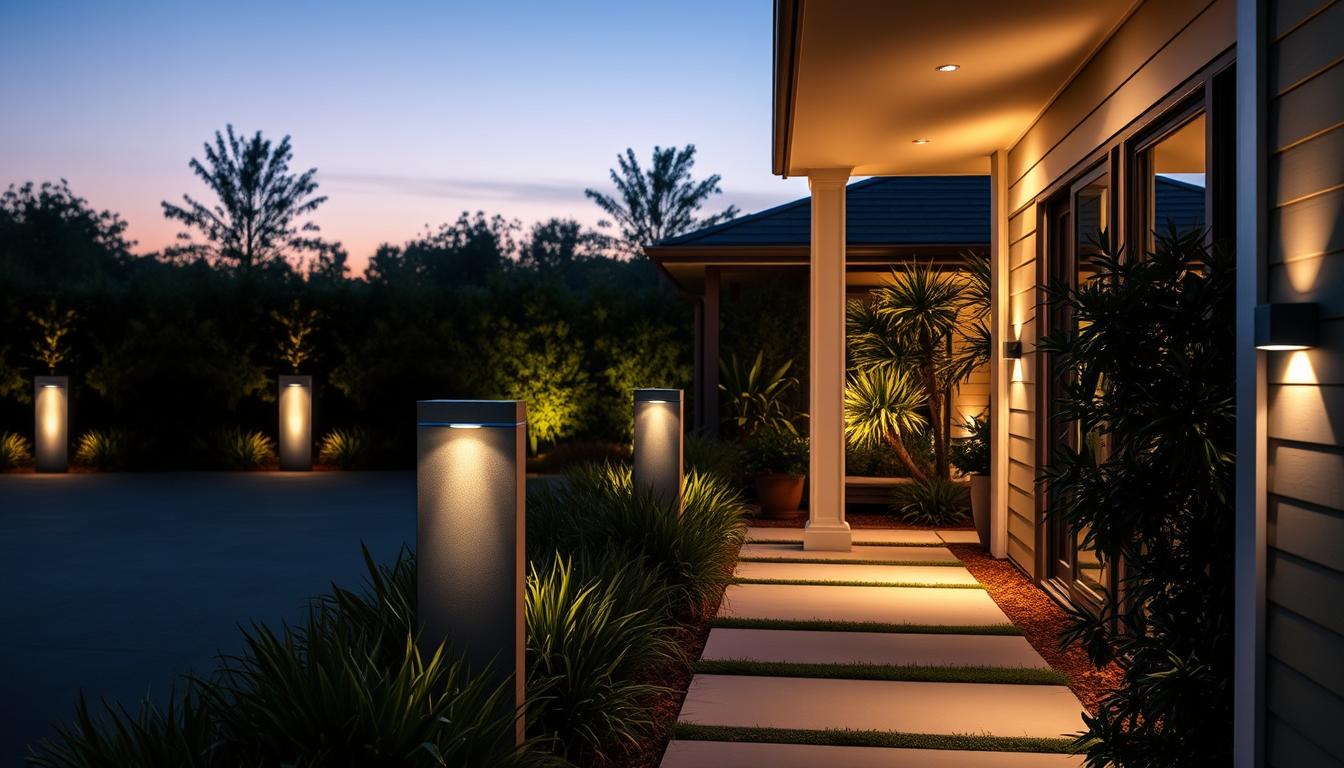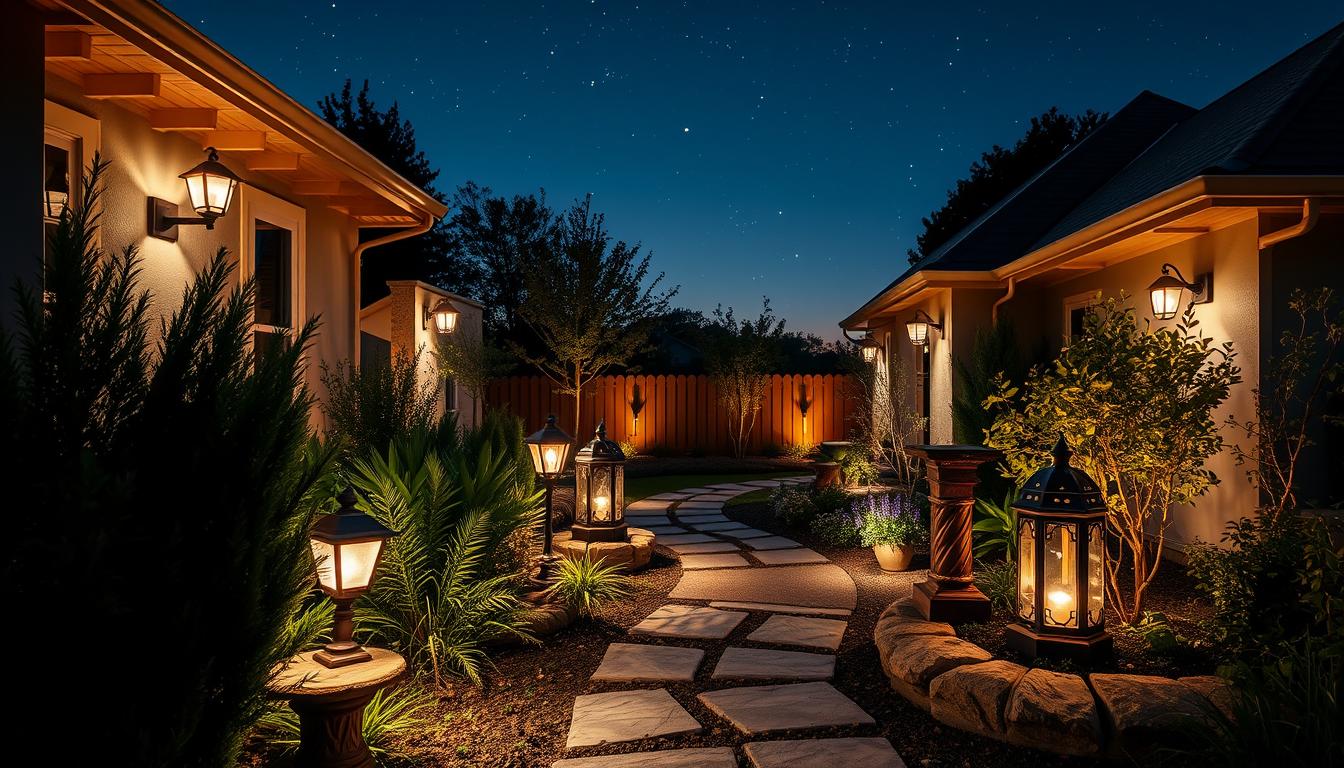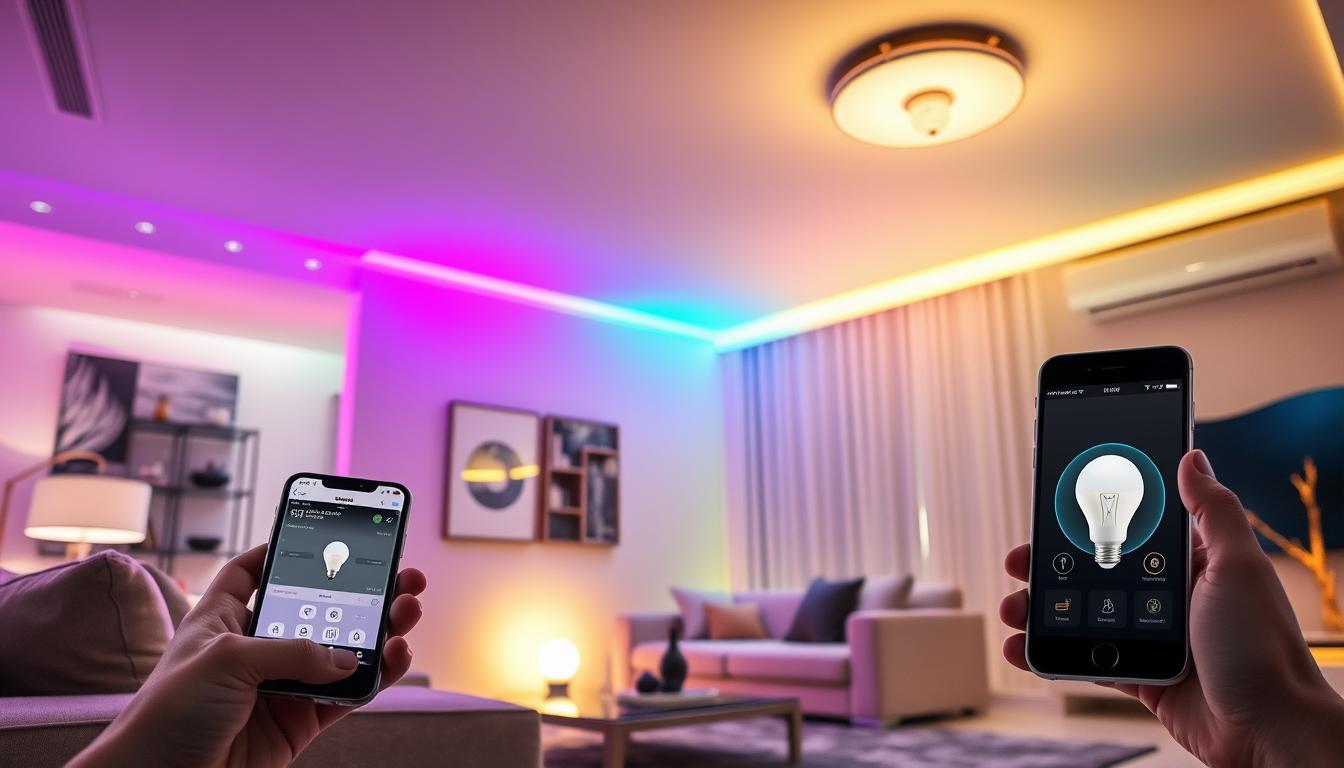Motion detection technology is key in home security, and lighting plays a big role in keeping burglars away. Motion sensor lights boost your home’s security and provide reliable lighting. They work by turning on when they sense movement, giving you peace of mind.
Installing motion sensor lights makes your home and family safer. These lights use motion detection to turn on and off. This tech is vital for security lighting, helping to keep intruders away and improve visibility.
Security lighting with motion detection has many perks, like saving energy and being easy to use. With motion sensor lights, you know your home is safe, even when you’re not there. This article will dive into motion sensor lights, their benefits, how to install them, and how to keep them working well.
Introduction to Motion Sensor Lights
Motion sensor lights are a great way to boost your home’s security. They’re easy to install and offer many benefits. Whether you want to make your home safer or add convenience, motion sensor lights are a smart choice.
Key Takeaways
- Motion sensor lights provide a sense of security and peace of mind
- Motion detection technology is designed to detect movement and trigger lights
- Security lighting with motion detection capabilities offers energy efficiency and convenience
- Motion sensor lights can deter burglars and improve visibility
- Proper installation and maintenance are essential for optimal performance
- Motion sensor lights can be integrated with existing security systems
Understanding Motion Sensor Lights and Their Security Benefits
Motion sensor lights are key in home security, helping to catch and scare off intruders. Knowing how they work helps homeowners pick the right security for their homes. Sensor adjustment lets users tweak the sensor’s sensitivity to fit their needs.
Motion sensor lights can target specific areas, like doors or yards. This is great for those who want to keep an eye on certain spots. Adjusting the sensor helps these lights work better and boost security.
Motion sensor lights offer many security perks. They can spot and scare off intruders and use less energy. They also turn on and off when needed, cutting down on false alarms. Plus, they can link up with other security gear for a full security package.
There are different kinds of motion detection systems, like passive infrared and microwave sensors. Each has its own strengths and weaknesses. Homeowners should think about what they need before picking a system. By picking the right lights and adjusting the sensor adjustment settings, they can build a strong and smart security system.
Choosing the Right Motion Sensors for Your Property
Choosing the right motion sensors for your property involves several key factors. These include the size of your property, the type of security lighting you need, and how much security you require. It’s important to research different types of motion sensors to find the best fit for your property.
A reliable power connection is essential for motion sensors to work well. You can choose between wireless and hardwired options. Wireless sensors are easy to install and flexible, while hardwired sensors offer a more stable and secure connection.
- Wireless motion sensors: ideal for small to medium-sized properties with minimal wiring requirements
- Hardwired motion sensors: suitable for larger properties or those requiring a more secure connection
When picking motion sensors, think about a few important things:
- Detection range and accuracy
- Sensitivity adjustment options
- Weather resistance and durability
- Compatibility with existing security systems
By considering these factors and choosing the right motion sensors, you can boost your security lighting and overall security. This will make your home safer and more secure for you and your family.
Essential Tools and Materials for Installation
Installing motion sensor lights needs the right tools and materials. You’ll need the necessary hardware and know how to adjust sensitivity settings for the best results. Proper installation ensures your lights work right, offering security and automated lighting for your home.
First, gather all the tools and materials you need. This includes a drill, screwdriver, wire strippers, and a voltage tester. Don’t forget safety gear like gloves, safety glasses, and a ladder for high places.
Required Tools Checklist
- Drill
- Screwdriver
- Wire strippers
- Voltage tester
Safety Equipment Recommendations
Having the right safety gear is crucial. Wear gloves to avoid cuts and electrical shock. Safety glasses protect your eyes from debris. Use a ladder safely to reach high spots.
Additional Optional Materials
You might need extra materials like wiring, mounting hardware, or a timer. Knowing how to use these with your motion sensor lights’ sensitivity settings and automated lighting makes them work better.
Optimal Placement Strategies for Maximum Coverage
To get the most out of motion detection, finding the right spot for your motion sensor lights is key. Think about your property’s layout and what kind of lighting you need. By placing your lights smartly, you can make sure no area is left uncovered.
When setting up your lights, keep these tips in mind:
- Entry points: Put lights near doors, windows, and other spots where people might come in. This helps catch any odd activity.
- Perimeter coverage: Set up lights around your property’s edges to make a safe boundary.
- Detection zones: Split your property into different detection zones. This lets you set up your motion detection just right and cut down on false alarms.
Using these tips, you can make your motion detection system work better. This will help keep your property safer. Adjust your plan based on what you need and how your property is laid out.
With some thought and the right placement, you can build a top-notch motion detection system. This will give you the best coverage and peace of mind.
Step-by-Step Installation Process
Installing motion sensor lights is easy if you know the steps. First, clean the area where you’ll install the lights. This makes sure there’s no dirt or debris. It also helps with a safe power connection.
Then, you’ll work on the wiring and power connection. This part can be tricky if you’re new to electrical work. Always follow the maker’s guide and be careful to avoid accidents.
Once the wiring is done, you can mount the light. This means attaching it to a wall or ceiling. Make sure it’s straight and securely attached. You might also need to adjust the sensor to catch motion right.
Key Installation Steps
- Prepare the installation site by cleaning and clearing debris
- Follow the wiring and power connection guide carefully
- Mount and secure the unit, ensuring it is level and fastened
- Perform sensor adjustment as needed to ensure correct motion detection
By following these steps and being careful, you can install your motion sensor lights well. This will help keep your home safer and more secure.
| Installation Step | Importance Level |
|---|---|
| Preparing the installation site | High |
| Wiring and power connection | High |
| Mounting and securing the unit | Medium |
| Sensor adjustment | Low |
Configuring Your Motion Sensor Settings
After installing your motion sensor lights, it’s key to set them up right. Adjusting the sensitivity settings helps prevent false triggers. It ensures the lights turn on when you need them. This setup also boosts your automated lighting experience, making life easier and saving energy.
First, learn about the settings on your motion sensor lights. You’ll find options for sensitivity, range, and timer settings. By tweaking these, you can tailor your lights to your liking.
Sensitivity Adjustment Tips
Adjusting sensitivity depends on your light’s location. For example, near a busy street or a pet area, lower the sensitivity to avoid false triggers. In secluded spots, increase it to catch even small movements.
Range and Detection Zone Setup
Setting the range and detection zone is crucial. You can adjust these to cover specific areas, like a porch or driveway. This is great for automated lighting systems, letting you customize the lighting.
Follow these tips to make your motion sensor lights work better. Adjust the sensitivity settings and range to get the best lighting. Always check your user manual for specific setup instructions. Enjoy the perks of automated lighting and better home security.
Weather Considerations and Durability Features
When you’re setting up security lighting with motion detection, think about your local weather. Extreme temperatures and moisture can harm your lights. Make sure your security lighting is weather-proof. Look for lights with waterproof housing and materials that don’t rust.
Here are some important features for durable motion sensor lights:
- IP65 or higher rating for weather resistance
- Corrosion-resistant materials, such as stainless steel or aluminum
- UV-resistant plastic to prevent discoloration
Choosing lights with these features means your security lighting will work well, even in bad weather. It will keep your place safe and well-lit.
Troubleshooting Common Issues
Motion sensor lights can sometimes have problems. These issues can affect how well they work and their security benefits. It’s important to regularly check and adjust these lights to make sure they’re working right. Adjusting the sensor’s sensitivity and setting up the right detection zones are key to their performance.
Some common problems include false triggers, power issues, and sensor malfunctions. First, check the wiring and connections to make sure they’re good. Then, tweak the sensor’s sensitivity to cut down on false alarms. Sometimes, you might need to adjust the detection zones to get the best results.
- Check the power source and connections to ensure they are secure and functioning correctly.
- Adjust the sensor’s sensitivity settings to minimize false triggers.
- Reconfigure the detection zones to optimize the motion sensor’s range and accuracy.
By following these steps and doing regular checks, you can keep your motion sensor lights in top shape. This ensures they provide the best security and peace of mind.
| Issue | Solution |
|---|---|
| False Triggers | Adjust sensor sensitivity settings, reconfigure detection zones |
| Power and Connection Problems | Check wiring and connections, ensure secure and functioning correctly |
| Sensor Malfunctions | Reconfigure detection zones, adjust sensor sensitivity settings |
Maintenance Tips for Long-Term Performance
Regular maintenance is key to keeping your security and automated lighting systems running smoothly. This means cleaning the lights and sensors, checking the wiring, and replacing batteries or bulbs when they’re out.
Here are some important maintenance tips to remember:
- Cleaning the lights and sensors regularly to prevent dirt and debris buildup
- Checking the wiring and connections to ensure they are secure and not damaged
- Replacing batteries or bulbs as needed to prevent system failure
By following these tips, you can make sure your lighting systems keep working well. This will help keep your home safe and secure.
Remember, regular maintenance is crucial for your lighting systems. By doing these simple tasks, you can make your systems last longer. This keeps your home safe and secure.
| Maintenance Task | Frequency |
|---|---|
| Cleaning lights and sensors | Every 2-3 months |
| Checking wiring and connections | Every 6 months |
| Replacing batteries or bulbs | As needed |
Integrating with Existing Security Systems
Adding motion sensor lights to your home security can make a big difference. It combines motion detection with other security devices for better protection. This setup can also include smart home features and security cameras for real-time monitoring.
Integrating motion sensor lights with your security system makes it more seamless. For instance, when a light detects movement, it can turn on alarms or cameras. This helps scare off intruders and provides evidence if needed. Security lighting can also change its brightness and duration based on the time, giving you more control.
Some popular ways to link motion sensor lights with your security system include:
- Smart home hubs, such as Samsung SmartThings or Apple HomeKit
- Security camera systems, such as Ring or Nest
- Home automation systems, such as Control4 or Crestron
Using these technologies, you can build a strong, connected security system. It offers peace of mind and protects your property. With the right setup, motion detection becomes a key tool against crime and vandalism.
| Integration Option | Benefits |
|---|---|
| Smart Home Hubs | Remote control, automated security protocols |
| Security Camera Systems | Real-time monitoring, video evidence |
| Home Automation Systems | Customizable security settings, seamless integration |
Advanced Features and Upgrade Options
Motion sensor lights have many advanced features and upgrade options. One key feature is automated lighting. This lets the lights turn on and off automatically when motion is detected. It’s very useful for outdoor lighting, helping to keep homes safe and deter intruders.
Another important feature is sensitivity settings. These allow users to adjust how sensitive the motion sensor is. It helps prevent false triggers and ensures lights only turn on when needed. Some lights also have timer settings and adjustable lighting duration.
- Smart home integration, which allows users to control their lights remotely using a smartphone app
- Energy-efficient LED bulbs, which can help to reduce energy consumption and save money
- Weather-resistant casing, which can help to protect the lights from the elements and extend their lifespan
Using these advanced features and upgrade options can greatly improve motion sensor lights. It enhances their performance and functionality. This makes homes more secure and safe.
Conclusion: Enhancing Your Home Security with Motion Sensor Lighting
Motion sensor lights are a simple yet effective way to boost your home’s security. They use motion detection technology to scare off burglars and light up your home. This makes your home safer and gives you peace of mind.
Installing motion sensor lights around your home’s edges and doors creates a strong defense. These lights turn on automatically, making your home welcoming and safe. This improves visibility and safety for you and your family.
Looking to make your home safer? Check out the many motion sensor lighting options out there. Find the one that fits your needs and budget. With the right tech and placement, your home will be a safe place for you and your family.





